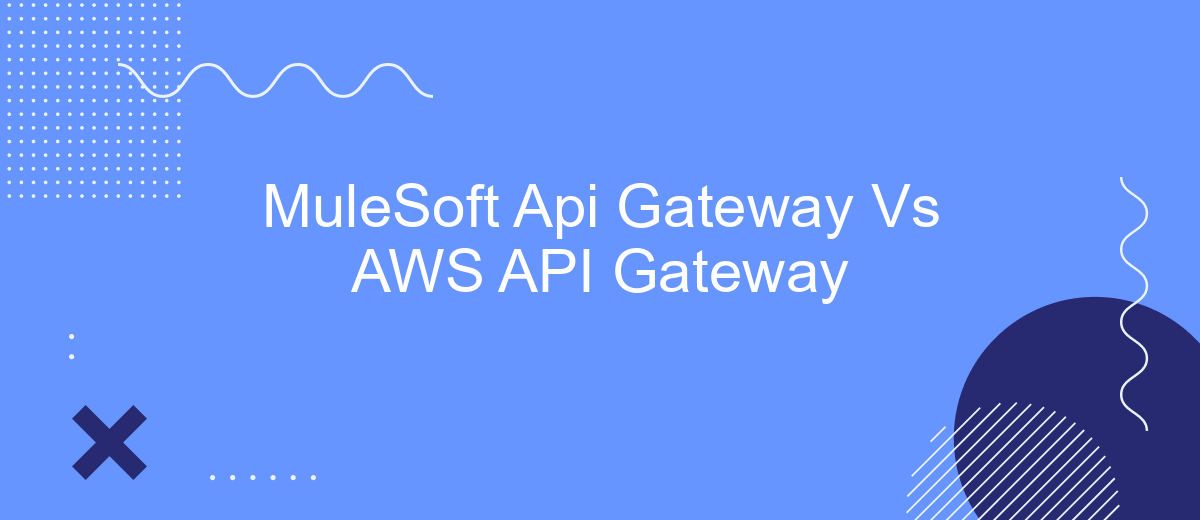When choosing an API gateway, businesses often compare MuleSoft API Gateway and AWS API Gateway. Both platforms offer robust features for managing, securing, and scaling APIs, but they cater to different needs and environments. This article delves into the key differences, advantages, and potential drawbacks of each, helping you make an informed decision for your specific use case.
Introduction
In today's rapidly evolving digital landscape, API gateways have become crucial for managing and optimizing the flow of data between different services and applications. Two of the most popular API gateway solutions are MuleSoft API Gateway and AWS API Gateway. Both platforms offer robust features and capabilities, but they cater to different needs and use cases.
- MuleSoft API Gateway: Known for its extensive integration capabilities and support for various protocols.
- AWS API Gateway: Offers seamless integration with AWS services and is highly scalable.
Choosing the right API gateway depends on several factors, including the specific requirements of your project, the existing technology stack, and the level of integration needed. For instance, tools like SaveMyLeads can simplify the integration process by automating data transfer between different platforms, making it easier to manage APIs effectively. Understanding the strengths and limitations of each gateway can help you make an informed decision that aligns with your business goals.
Architecture and Components

MuleSoft API Gateway and AWS API Gateway are both robust solutions for managing APIs, but they differ significantly in their architecture and components. MuleSoft API Gateway is part of the Anypoint Platform, which provides a unified, flexible integration platform for connecting applications, data, and devices. It includes components like the Anypoint Studio for design and development, Anypoint Exchange for sharing APIs and connectors, and Anypoint Management Center for monitoring and analytics. MuleSoft's architecture emphasizes a seamless integration experience with a strong focus on reusability and scalability.
On the other hand, AWS API Gateway is a fully managed service that makes it easy for developers to create, publish, maintain, monitor, and secure APIs at any scale. It integrates deeply with other AWS services, such as Lambda for serverless computing, DynamoDB for database services, and IAM for access control. AWS API Gateway's architecture is designed to handle large-scale, high-performance API traffic with minimal operational overhead. Both solutions offer robust tools for API management, but MuleSoft's comprehensive integration capabilities make it a strong choice for complex, enterprise-level integrations. For example, services like SaveMyLeads can be easily integrated using MuleSoft's tools to automate lead management processes efficiently.
Features and Capabilities

When comparing MuleSoft API Gateway and AWS API Gateway, it is essential to understand their distinct features and capabilities. Both platforms offer robust solutions for managing APIs, yet they cater to different needs and preferences.
- Integration Capabilities: MuleSoft excels in seamless integration with various enterprise systems, including CRM, ERP, and databases. AWS API Gateway, on the other hand, integrates effortlessly with AWS services like Lambda, DynamoDB, and S3.
- Security Features: MuleSoft provides comprehensive security policies, including OAuth 2.0, JWT, and IP whitelisting. AWS API Gateway offers similar security features, with additional benefits like AWS WAF for web application protection.
- Scalability: AWS API Gateway is highly scalable, leveraging AWS's global infrastructure. MuleSoft also offers scalability but is more focused on hybrid integrations, supporting both on-premises and cloud environments.
- Monitoring and Analytics: MuleSoft provides detailed analytics and monitoring through Anypoint Monitoring. AWS API Gateway integrates with CloudWatch for extensive monitoring and logging capabilities.
Both MuleSoft API Gateway and AWS API Gateway offer powerful tools for API management. While MuleSoft is ideal for complex, multi-system integrations, AWS API Gateway is a great choice for those heavily invested in the AWS ecosystem. For businesses looking to streamline lead management and integration processes, services like SaveMyLeads can further enhance the efficiency of these API gateways.
Comparison and Key Differences

When comparing MuleSoft API Gateway and AWS API Gateway, it's essential to consider their unique features and capabilities. Both platforms offer robust API management solutions, but they cater to different needs and use cases.
MuleSoft API Gateway is known for its extensive integration capabilities and seamless connectivity with various applications and services. It is particularly beneficial for enterprises looking to integrate complex systems and data sources. On the other hand, AWS API Gateway excels in scalability and ease of use, making it ideal for developers who need to quickly deploy and manage APIs in the cloud.
- Integration Capabilities: MuleSoft offers advanced integration features, including connectors for numerous applications, while AWS focuses on cloud-native integrations.
- Scalability: AWS API Gateway provides automatic scaling to handle high traffic volumes, whereas MuleSoft requires manual configuration for scaling.
- Ease of Use: AWS API Gateway is user-friendly with a straightforward setup process, whereas MuleSoft has a steeper learning curve due to its extensive features.
- Cost: AWS API Gateway generally offers a pay-as-you-go pricing model, while MuleSoft's pricing can be higher due to its comprehensive integration capabilities.
In summary, the choice between MuleSoft API Gateway and AWS API Gateway depends on your specific needs. For complex integrations and enterprise-level requirements, MuleSoft is a strong contender. For scalable, cloud-native API management with ease of use, AWS API Gateway is an excellent choice. Additionally, services like SaveMyLeads can further streamline your integration processes, making it easier to connect various platforms and automate workflows.
Conclusion
In conclusion, both MuleSoft API Gateway and AWS API Gateway offer robust solutions for managing and securing APIs, each with its unique strengths. MuleSoft excels in providing a comprehensive integration platform that supports a wide range of protocols and connectors, making it ideal for complex enterprise environments. AWS API Gateway, on the other hand, is deeply integrated with other AWS services, offering seamless scalability and cost-efficiency for users already within the AWS ecosystem.
When choosing between the two, it's essential to consider your specific requirements, such as the need for extensive integration capabilities or the desire to leverage existing AWS infrastructure. Tools like SaveMyLeads can further enhance your API management strategy by automating lead data transfers between various services, ensuring that your integrations are both efficient and effective. Ultimately, the best choice will depend on your organization's unique needs and existing technology stack.
- Automate the work with leads from the Facebook advertising account
- Empower with integrations and instant transfer of leads
- Don't spend money on developers or integrators
- Save time by automating routine tasks
FAQ
What are the primary differences between MuleSoft API Gateway and AWS API Gateway?
Which platform is better for handling high volumes of API requests?
How do MuleSoft and AWS API Gateway handle security?
Can I use automation tools to integrate MuleSoft or AWS API Gateway with other services?
Which platform has better support and community resources?
Use the SaveMyLeads service to improve the speed and quality of your Facebook lead processing. You do not need to regularly check the advertising account and download the CSV file. Get leads quickly and in a convenient format. Using the SML online connector, you can set up automatic transfer of leads from Facebook to various services: CRM systems, instant messengers, task managers, email services, etc. Automate the data transfer process, save time and improve customer service.

